
Operator and Parts Manual
Blower Kit
44" Collection System
966004401

Operator and Parts Manual
Blower Kit
44" Collection System
966004401
??2009 HTC. All Rights Reserved.
Beatrice, NE. Printed in U.S.A.

CONTENTS
CONGRATULATIONS on the purchase of a new collection system. It has been designed, engineered and manufactured to give you the best possible dependability and performance.
Should you experience any problem you cannot easily remedy, please contact your nearest authorized service center/ department. They have competent,
Please read and retain this manual. The instructions will enable you to assemble and maintain your collection system properly. Always observe the ???SAFETY RULES???.
KNOW YOUR BLOWER SYSTEM
READ THIS OPERATION MANUAL AND SAFETY
RULES BEFORE ASSEMBLING OR OPERATING YOUR BLOWER SYSTEM. Compare the illustrations with the carton contents to familiarize yourself with the parts before starting the assembly. Study the operating instructions and safety precautions thoroughly to insure proper functioning of your Grass Catcher and to prevent injury to yourself and others. Save this manual for future reference.
WARNING!
Engine exhaust, some of its constituents, and certain vehicle components contain or emit chemicals known to the State of California to cause cancer and birth defects or other reproductive harm.
The operation of any mower can result in foreign objects thrown into the eyes, which can result in severe eye damage. ALWAYS wear safety glasses or eye shields before starting your mower and while mowing. Standard safety glasses are recommended or a wide vision safety mask for over spectacles.

SAFETY RULES
SAFE OPERATION PRACTICES FOR 
DANGER !
THIS CUTTING MACHINE IS CAPABLE OF AMPUTATING HANDS AND FEET AND THROWING OBJECTS.
FAILURE TO OBSERVE THE FOLLOWING SAFETY INSTRUCTIONS COULD RESULT IN SERIOUS INJURY
OR DEATH.
GENERAL OPERATION
???Read, understand and follow all instructions in the manual and on the machine before starting.
???Only allow responsible adults, who are familiar with the instructions, to operate the machine.
???Clear the area of objects such as rocks, stones, toys, wire etc., which could be picked up and thrown by the blades.
???Be sure the area is clear of all people and pets before mowing. Stop the machine if anyone enters the area.
???Never carry passengers or children even with blades off.
???Do not mow in reverse unless absolutely necessary. Always look down and behind before and while backing.
???Be aware of the mower discharge direction and do not direct it towards anyone. Do not operate the mower without either the entire grass catcher or the guard in place.
???Slow down before turning.
???Never leave the machine unattended when the engine is running. Always turn off the blades, set the parking brake, stop the engine and remove the key before leaving the machine.
???Turn off blades when not mowing.
???Stop engine before removing grass catcher or unclogging chute.
???Mow only in daylight or good artificial light.
???Do not operate the machine while under the influence of alcohol or drugs.
???Watch out for traffic when operating near or crossing roadways.
???Use extra care when loading and unloading the machine onto a trailer or truck.
???Data indicates that operators, age 60 years and above, are involved in a large percentage of riding
???DO NOT operate mower with grass catcher, unless the front weights are installed.
???Keep machine free of grass, leaves or other debris buildup which can touch hot exhaust/engine parts and burn. Do not allow the mower deck to plow leaves or other debris which can cause buildup
to occur. Clean any oil or fuel spillage before operating or storing the machine. Allow machine to cool before storage.
SLOPE OPERATION
Slopes are a major factor related to
DO
???Mow up and down slopes (10?? Max.), not across.
???Remove obstacles such as rocks, tree limbs, etc.
???Watch for holes, ruts, or bumps. Uneven terrain could overturn the machine. Tall grass can hide obstacles.
???Use slow speed. Choose a low speed so that you will not have to stop while on the slope.
???Use extra care with grass catchers or other attachments. These can change the stability of the machine.
???Keep all movement on the slopes slow and gradual. Do not make sudden changes in speed or direction.
???Avoid starting or stopping on a slope. If tires lose traction, disengage the blades and proceed slowly straight down the slope.
4

SAFETY RULES
 SAFE OPERATION PRACTICES FOR
SAFE OPERATION PRACTICES FOR 
DO NOT
???Do not turn on slopes unless necessary, and then, turn slowly and gradually downhill, if possible.
???Do not mow near
???Do not mow on wet grass. Reduced traction could cause sliding.
???Do not try to stabilize the machine by putting your foot on the ground.
CHILDREN
Tragic accidents can occur if the operator is not alert to the presence of children. Children are often attracted to the machine and the mowing activity. Never assume that children will remain where you last saw them.
???NEVER allow children to operate the machine.
???Keep children out of the mowing area and under the watchful care of another responsible adult.
???Be alert and turn off the machine if children enter the area.
???Before and when backing, look behind and down for small children.
???Never carry children. They may fall off and be seriously injured or interfere with safe machine operation.
SERVICE
???The operation of any mower can result in foreign objects thrown into the eyes, which can result
in severe eye damage. Always wear safety glasses or eye shields while operating your mower or performing any adjustments or repairs.
We recommend a wide vision safety mask over spectacles or standard safety glasses.
???Use extra care in handling gasoline and other fuels. They are flammable and vapors are explosive.
-Use only an approved container.
-Never remove gas cap or add fuel with the engine running.
-Allow engine to cool before refueling.
-Do not smoke.
-Never refuel the machine indoors.
-Never store the machine or fuel container inside where there is an open flame, such as a water heater.
???Never run a machine inside a closed area.
???Keep nuts and bolts, especially blade attachment bolts, tight and keep equipment in good condition.
???Never tamper with safety devices. Check there proper operation regularly.
???Use extra care when approaching blind corners, shrubs, trees, or other objects that may obscure vision.
CAUTION
In order to prevent accidental starting when setting up, transporting, adjusting or making repairs, always disconnect spark plug wire and place wire where it cannot contact spark plug.
5

SAFETY RULES
 SAFE OPERATION PRACTICES FOR
SAFE OPERATION PRACTICES FOR 
???Keep machine free of grass, leaves, or other debris buildup. Clean oil or fuel spillage. Allow machine to cool before storing.
???Stop and inspect the equipment if you strike an object. Repair, if necessary, before restarting.
???Never make adjustments or repairs with the engine running.
???Grass catcher components are subject to wear, damage, and deterioration, which could expose moving parts or allow objects to be thrown.
Frequently check components and replace with manufacturer???s recommended parts, when necessary.
???Mower blades are sharp and can cut. Wrap the blade(s) or wear gloves, and use extra caution when servicing them.
???Check brake operation frequently. Adjust and service as shown in the Operator???s Manual.
WARNING!
Battery posts, terminals and related accessories contain lead and lead compounds, chemicals know to the State of California to cause cancer and birth defects or other reproductive harm. Wash hands after handling.
WARNING!
DO NOT tow any trailers, etc. with this mower. They may jackknife or over turn causing damage to the mower and possibly serious injury to the operator.
6
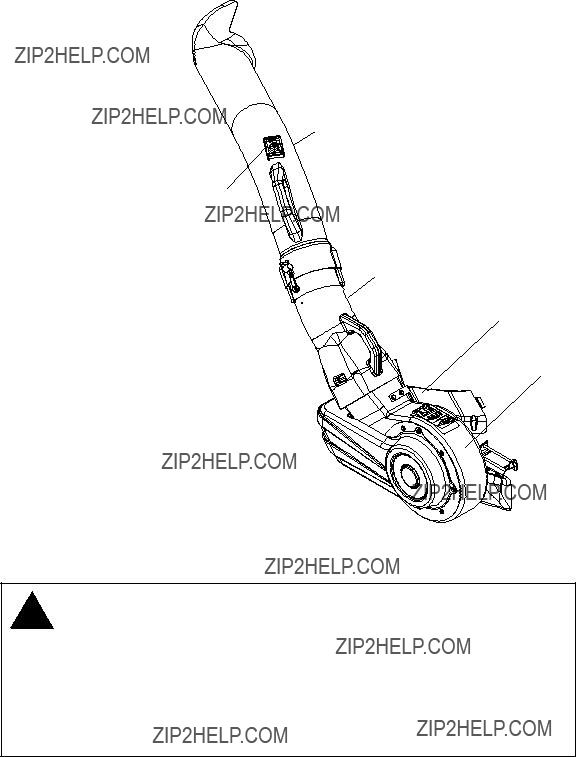
UNPACKING INSTRUCTIONS
???Remove all parts and packing materials from carton.
TOOLS REQUIRED
???7/16" Wrench or ratchet and socket
?????" Wrench or ratchet and socket
???Hacksaw
???Pliers
???Drill and 7/8" bit
Bag Dump Indicator
CONTAINER CONTENTS
???Weight
Upper Chute
Middle Chute
Belt Cover
Blower Housing
NOTE: When right hand (R.H.) and left hand (L.H.) are mentioned in this manual, it means when you are seated on the mower in the operator???s position.
CAUTION
BEFORE ASSEMBLING GRASS CATCHER TO MOWER:
???Set parking brake.
???Place motion control levers in ???NEUTRAL??? position.
???Turn ignition key ???OFF??? and remove key.
???Make sure the blades and all moving parts have completely stopped.
???Disconnect spark plug and place wire where it cannot come in contact with plug.
7
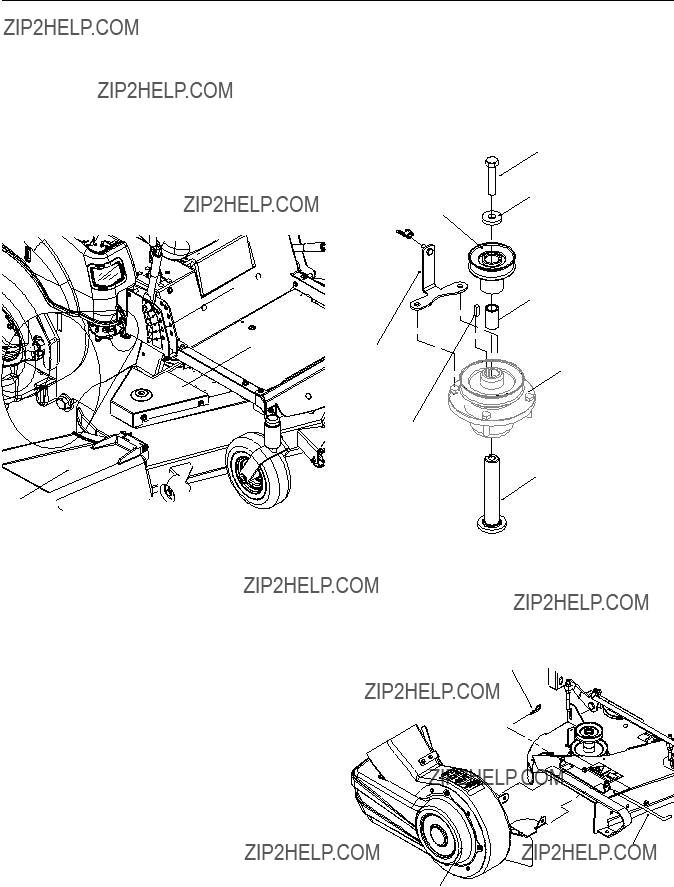
ASSEMBLY
1INSTALLING DRIVE PULLEY
1.Remove the discharge chute from the deck. (Deck configuration will vary by size and model)
2.Lower deck to the lowest cutting position.
3.To prevent interference with the new belt shield, reverse the bolt/nut assembly on the rear of the deck height adjustment plate.
4.Remove the right hand (discharge side) belt cover
from the deck.
8.Use heavy washer and bolt supplied in kit to attach pulley to spindle. Torque to
9.Reinstall the deck belt.
New Bolt
New Heavy Washer
Drive Pulley
Discharge Chute
Chute


5.Remove the bolt securing the right hand deck pulley to the spindle.
6.Replace right blade shaft with new, longer shaft.
The existing drive pulley and key will fit on the new shaft. Install blower drive pulley with the raised portion of pulley hub down. Slide spacer inside new pulley. Add key to new pulley.
7.Remove two rear bolts from spindle and place belt shield standoff where the two bolts were removed. Replace bolts and tighten.
Replacement Shaft
2MOUNTING BLOWER ASSEMBLY
1.Install the front mount bracket to the deck with the pin and hairpin cotter supplied with the kit.
Hairpin Cotter
Pin
Outer Pulley Cover
8

ASSEMBLY
3INSTALLING HOLD DOWN BRACKET
1.Temporarily secure the hold down bracket to the skid plate, using a bolt and nut from the kit and the outer hole in the bracket.
If needed, prop the blower housing up so it sits vertically level, but leave no more than an 1/8" gap between the deck and blower housing.
4INSTALLING DRIVE BELT
1.Make sure the tension release lever is forward or disengaged.
2.Place the belt over the pulley on the deck. Refer to illustration for proper routing.
3.Move the tension release arm to the rear and engage in the latch.
2.Using the
3.Remove blower housing. Place
5INSTALLING BELT COVERS
1.Place the deck belt shield on the deck over the drive pulley and secure with hardware removed from steel belt shield.
2.Place retainer on the outer pulley cover.
3.Align the tab end of the belt cover into the slot on the deck belt shield and the other end over the end of the outer pulley cover.
4.Secure with knob.
Knob
Belt Cover Tab
Middle Chute Latch
Retainer
Deck Belt Shield 




Outer Pulley Cover
9
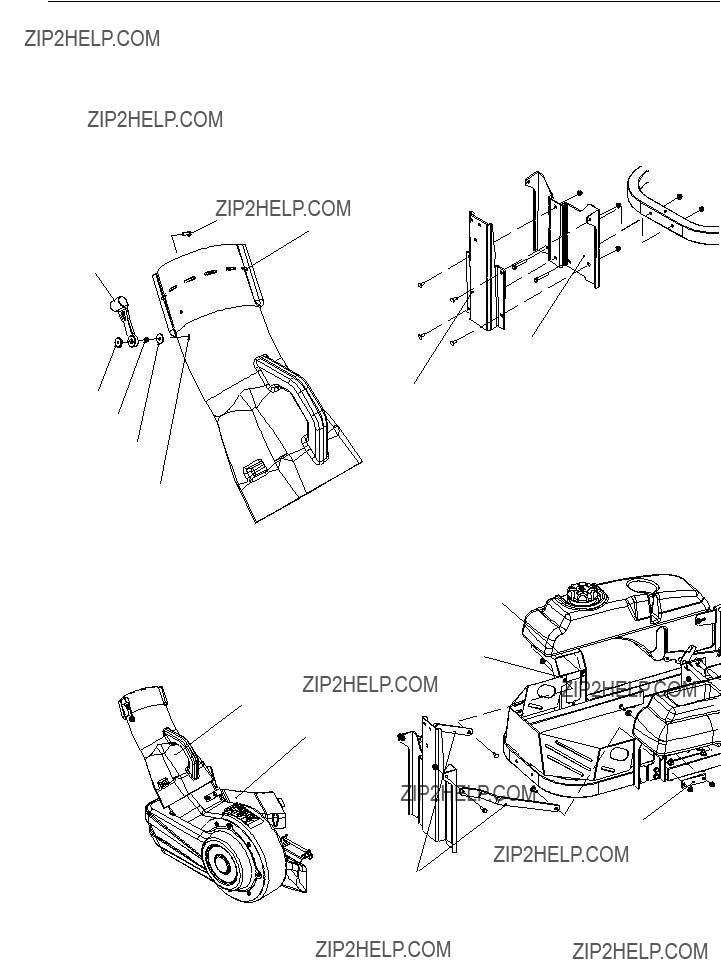
ASSEMBLY
6TRIMMING MIDDLE CHUTE
1.Using the hacksaw, trim along the dashed line.
2.Locate the middle chute, flat washer, hood latch, weld nut, lock washer and machine screw from kit.
3.Install in the appropriate hole at the upper end of the middle chute, according to deck size.
7INSTALLING BAGGER MOUNT
1.Using hardware provided in kit, attach support mount to unit.
2.Attach hanger bracket to support mount. Do not fully tighten nuts at this time.
Machine Screw
Hood Latch
Weld Nut
Lock Washer
Flat Washer
Latch Location
Trim Line
Support Mount
Hanger Bracket
3.Secure rear end of support straps to outside of hanger assembly. Set reinforcement plates to the outside of the tank brackets and fasten front end of support strap to tank bracket and reinforcment plate with round head bolt. Secure front end
of reinforcement plate to tank bracket with hex bolt. Fully secure all mounting hardware. See illustration.
NOTE: Rear guard hole may need to be drilled out to 5/16" if kit hardware is too large.
7INSTALLING MIDDLE CHUTE
1.Place middle chute over the top end of the blower assembly.
2.Latch middle chute to blower assembly.
Middle Chute
Blower Assembly
Hex Bolt Placement
Round Head
Bolt Placement
Reinforcement Plate
Support Straps
10

ASSEMBLY
8INSTALLING WEIGHT KIT
1.Bolt cast weight to weight brackets using
2.Slide both weight brackets over the front tube on the frame. Be sure to position the weight assembly in the center of the frame.
3.Secure with
Front Tube
Weight Plate
3?? Bolt
Weight Bracket
CAUTION
DO NOT operate mower with grass catcher without front weight installed.
9MOUNTING COVER ASSEMBLY
NOTE: Assistance from another person may ease mounting the cover assembly to mower.
1.Lift and rotate cover to align the cover brackets with support assembly tubes.
2.Slide the cover down over the support tubes until secure.
10INSTALLING SPACER PLUGS
1.Remove plastic end caps from the center bag support arm. Fully insert spacer plug into the end of the support tube. It may be necessary to tap the spacer into place with a hammer or mallet.
Replace the plastic end cap back over the spacer.
The additional extension will hold the hood more securely when latched.
11
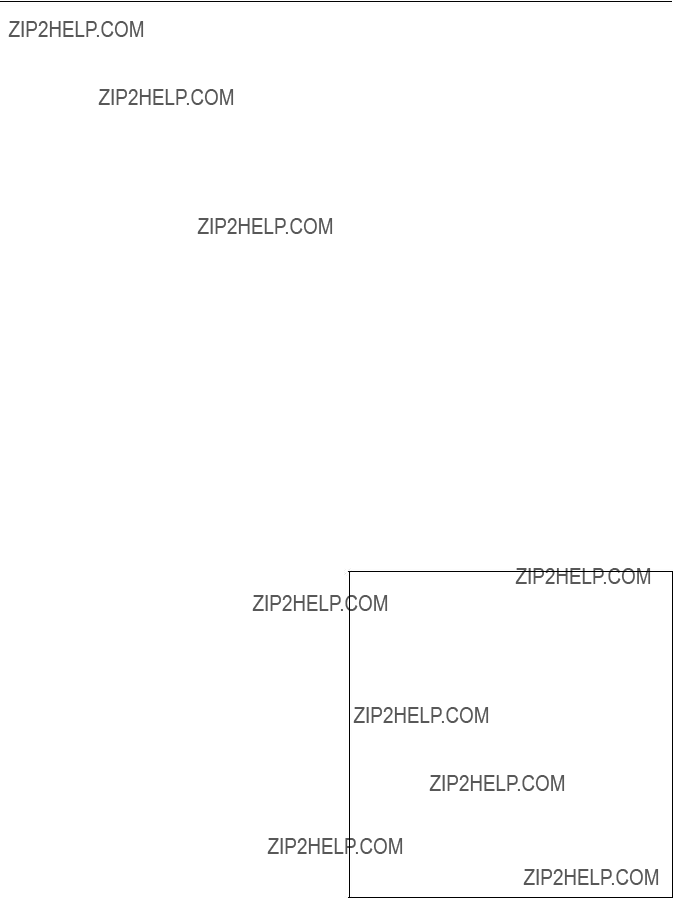
OPERATION
TIPS FOR IMPROVED BAGGING
Follow the mower operation instructions in you mower operator???s manual.
When operating your grass catcher on a lawn where grass and leaf bagging equipment has not been used, you are picking up thatch and debris that has accumulated for long periods of time. The amount collected and the total time of operation may be greater than you will experience with regular use of your grass catcher.
???Always run throttle at full speed when bagging.
???Select a speed low enough to give good mower cutting performance, good quality cut and good bagging performance.
NOTE: It may be necessary to overlap width of cut to suit your conditions.
???If grass is extremely tall, it should be mowed twice. The first time relatively high, the second time to desired height.
???Use left hand side of mower for trimming.
???Plastic trash bags (3.0 mil, 30 gallon) can be inserted inside grass catcher containers for ease of debris disposal. To remove the plastic trash bags when full:
a.Disengage blades, shift into neutral, engage the parking brake and stop the engine.
b.Unlatch and raise cover.
c.Remove one container at a time by grasping container handles and pulling toward the rear, off of the tube rails.
d.With the container resting on the ground, close and secure the top of the plastic lawn bag.
e.Tip the container on its side and slide the filled bag from the container.
f.Install a new plastic lawn bag with the edges of the bag draped over upper lip of the
Container (for replacement bags refer to
REPLACEMENT PARTS).
g.Repeat for other container.
h.Reinstall containers making sure right container overlaps left container at center supports.
i.Close cover and secure latches over center support tubes.
???Avoid cutting wet grass or in the morning while the dew is still heavy. Grass clippings collected under these conditions tend to be sticky and adhere to the walls of the flow path causing clogging.
???If the grass catcher fails to pick up cut grass or leaves, it is an indication that clogging has occurred in the system or that the grass catcher containers are full.
a.Disengage blades, place motion control levers in neutral position.
-Unlatch and raise cover.
-Slide out containers and dispose of clippings.
-Replace containers, close cover, and latch.
b.Unlatch chutes and check for clogging.
-Remove all debris in chute.
-Reassemble and latch chutes.
GENERAL RECOMMENDATIONS
Always observe safety rules when performing any maintenance.
???Before each use check for loose fasteners.
???Clean unit thoroughly after each use.
BLADE CARE
For best results mower blades must be kept sharp.
Replace bent or damaged blades.
???See BLADE CARE instructions in your mower operator???s manual.
 CAUTION
CAUTION
BEFORE PERFORMING
MAINTENANCE, SERVICE OR
ADJUSTMENTS:
???Set parking brake.
???Place motion control levers in ???NEUTRAL??? position.
???Place clutch control in ???DISENGAGED??? position.
???Turn ignition key to ???OFF??? position.
???Make sure blades and all moving parts have completely stopped.
???Disconnect spark plug wire(s) from spark plug(s) and place wire where it cannot come in contact with plug.
12

OPERATION
STORAGE
When grass catcher is to be stored for a period of time, clean it thoroughly, remove all dirt, grass, leaves, etc. Store in a clean, dry place.
CAUTION
???DO NOT operate mower with grass catcher partially installed.
???Disengage blades and stop engine before leaving mower seat to empty containers, unclogging chutes, etc.
???Close cover before starting.
???Disengage mower blades when crossing driveways or gravel surfaces and other areas where thrown objects could be a hazard.
???DO NOT attempt to vacuum cans or other potentially hazardous projectiles.
CAUTION
Do not leave grass in bagger containers. Empty containers after each use and before storing. Failure to do so may result in spontaneous combustion which could develop into a fire.
CAUTION
Grass catcher components are subject to wear, damage and deterioration, which could expose moving parts or allow objects to be thrown. Frequently check components and replace with manufacturer???s recommended parts, when necessary.
13

REPAIR PARTS
46
44
24
34
40
11
32 11
57
3
20
14

REPAIR PARTS
NOTE: ALL FASTENERS ARE GRADE 5 UNLESS OTHERWISE SPECIFIED.
15
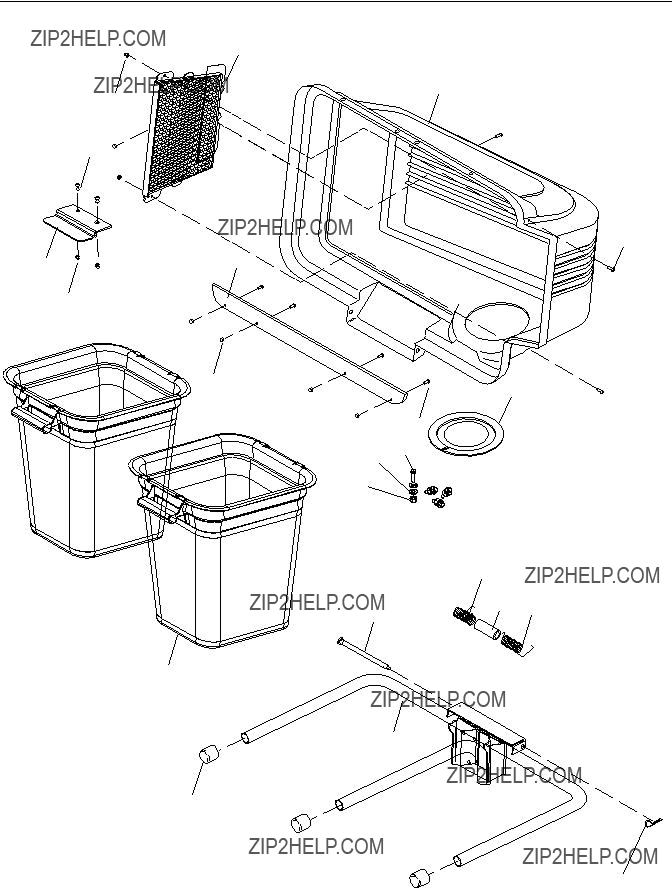
REPAIR PARTS
2
1
17
5
5
17
19
14 16
15
13
11
10
9
16

REPAIR PARTS
NOTE: ALL FASTENERS ARE GRADE 5 UNLESS OTHERWISE SPECIFIED.
17
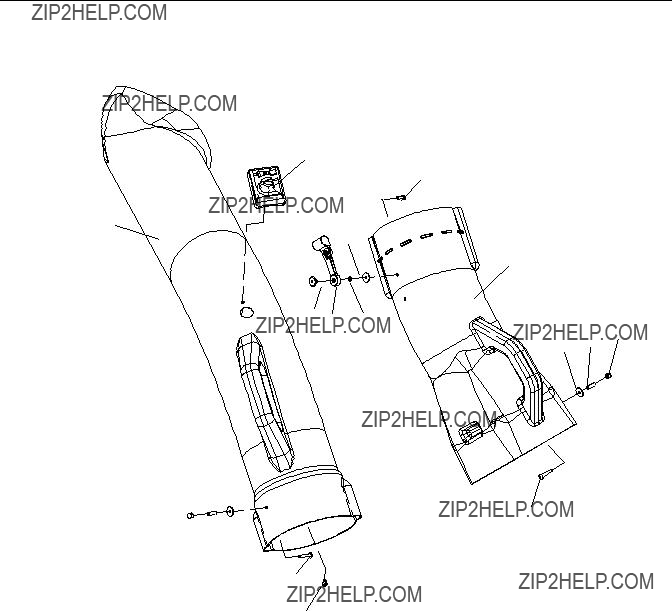
REPAIR PARTS
2
9
12
4
11
8 7 10
4 5 6
3
3
1
18

REPAIR PARTS
NOTE: ALL FASTENERS ARE GRADE 5 UNLESS OTHERWISE SPECIFIED.
19

REPAIR PARTS
29
32
26
28
4
31
22
24
 1
1
7
22
24





25
23
14
13
15
12
17 20
3 




18
 1
1
21
20

REPAIR PARTS
NOTE: ALL FASTENERS ARE GRADE 5 UNLESS OTHERWISE SPECIFIED.
21